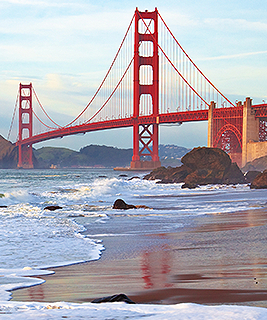Technologically advanced, sustainable and resilient infrastructure can pave the way for an inclusive post-COVID economic recovery. Low- and middle-income countries could see $4 return for every $1 spent on building infrastructure that focuses on long-term resilience.”
Countries around the globe are set to launch the biggest round of infrastructure investment since the post-2008 financial crisis stimulus measures
World Economic Forum, 2020
Resilience
Public and private infrastructure assets have historically offered the following attractive characteristics:
Global listed infrastructure EBITDA remained positive through the 2008 global financial crisis
Global listed infrastructure vs global equities EBITDA growth since 2004
Infrastructure’s key strengths in the current environment
| Defensive sector |
|
|---|---|
| Opportunistic |
|
| Economic |
|
| Inflation Hedge |
|
** As of May 31, 2020 the S&P Global INFRA INDEX WAS DOWN 18.34%. [S&P GLOBAL INFRA INDEX IS AN UNMANAGED INDEX CONSIDERED REPRESENTATIVE OF THE INFRASTRUCTURE MARKET.]
Spending shortfalls—projected to totalsome $5.5 trillion worldwide when compared with the level needed to maintain current GDP growth—are already straining global infrastructure.
McKinsey Global Institute, December 31, 2019
Key drivers of infrastructure investing
Global urbanization is increasing demand for new infrastructure
| 2018 – 2035 Projection | |||
|---|---|---|---|
| Rank | City | Pop.Change (millions) |
Percentage Change |
| 1 | Delhi, India | 14.8 | 52% |
| 2 | Tokyo, Japan | -1.5 | -4% |
| 3 | Shanghai, China | 8.8 | 34% |
| 4 | Dhaka, Bangladesh | 11.7 | 60% |
| 5 | Al-Qahirah (Cairo), Egypt | 8.4 | 42% |
| 6 | Mumbai (Bombay), India | 7.4 | 37% |
| 7 | Kinshasa, DRC | 13.5 | 102% |
| 8 | Mexico City, Mexico | 3.8 | 18% |
| 9 | Beijing, China | 5.7 | 29% |
| 10 | São Paulo, Brazil | 2.8 | 13% |
| 11 | Lagos, Nigeria | 11.0 | 81% |
| 12 | Karachi, Pakistan | 7.7 | 50% |
| 13 | New York-Newark, US | 2.0 | 11% |
| 14 | Chongqing, China | 5.7 | 38% |
| 15 | Kolkata (Calcutta), India | 4.9 | 33% |
| 16 | Lahore, Pakistan | 7.4 | 63% |
| 17 | Manila, Philippines | 5.2 | 38% |
| 18 | Kinki M.M.A. (Osaka), Japan | -0.9 | -5% |
| 19 | Bangalore, India | 6.6 | 58% |
| 20 | Istanbul, Turkey | 3.2 | 22% |
| 21 | Buenos Aires, Argentina | 2.2 | 14% |
| 22 | Guangzhou, Guangdong, China | 4.1 | 32% |
| 23 | Tianjin, China | 3.2 | 24% |
| 24 | Chennai (Madras), India | 4.9 | 47% |
| 25 | Shenzhen, China | 3.3 | 28% |
| Rank | City | Pop.Change (millions) |
Percentage Change |
|---|
Cumulative Infrastructure Investment at current trends vs needs (US$tn)
Total forecast infrastructure gaps mapped out
Population growth putting a strain on current infrastructure
The UN estimates that the world’s population is projected to grow from 7.5bn in 2017 to reach 9.8bn by 2050
Government infrastructure spending is center stage
 Belt and Road Initiative
Belt and Road Initiative |
 Nationwide public safety broadband network
Nationwide public safety broadband network |
 Bridge improvements a must
Bridge improvements a must |
 Increased infrastructure investment a must for economic growth & recovery
Increased infrastructure investment a must for economic growth & recovery
|
 Reduce congestion while connecting urban and rural
Reduce congestion while connecting urban and rural |
 Targeted to incentivize much needed private sector investment
Targeted to incentivize much needed private sector investment |
Post COVID-19 world — we expect global demand for infrastructure spending to increase
Republicans and Democrats are in agreement on the crucial need for national infrastructure spending for both current and long term needs
|
Potential impact of a $2 trillion spending package over 10 years on the US economy2
|
Infrastructure spending plans are already being announced at the state level
|
Infrastructure investment is already rising in China as it recovers from the COVID-19 crisis5
|
The rest of the world is following suit accelerating infrastructure spending plans
|
1 New York Times article “Trump and Democrats Agree to Pursue US$2 Trillion Infrastructure Plan”, April 30, 2020.
2 Source: Infrastructure: What Once Was Lost Can Now Be Found — The Productivity Boost, S&P Global, April 2020.
3 Illinois.gov, May 12, 2020.
4 USDA.gov, May 13, 2020.
5 HSBC Global Research, May 15, 2020.
6 Morgan Stanley Research, June 1, 2020.
7 Source: Investment Week, March 11, 2020.
8 Source: Construct Connect, May 14, 2020.
9 Source: Thomson Reuters, May 14, 2020.

 Essential services supporting the community
Essential services supporting the community
 High barrier to entry
High barrier to entry
 Potential for robust cash flows
Potential for robust cash flows
 Low demand elasticity
Low demand elasticity
 Underlying cash flows linked to
inflation
Underlying cash flows linked to
inflation
 Low correlation with other asset classes
Low correlation with other asset classes
 Long operational life
Long operational life
 Defensive in nature
Defensive in nature
 Aging infrastructure and the infrastructure deficit
Aging infrastructure and the infrastructure deficit
 Population growth has led to a young, growing working-age population
Population growth has led to a young, growing working-age population
 Urbanization is putting strain on current infrastructure
Urbanization is putting strain on current infrastructure
 Technological advancement and increasing societal expectations
Technological advancement and increasing societal expectations
 Foreign Direct Investing is a growth driver of infrastructure investment
Foreign Direct Investing is a growth driver of infrastructure investment
 COVID-19 recovery programs include significant Infrastructure spending
COVID-19 recovery programs include significant Infrastructure spending
